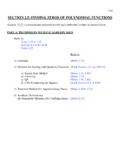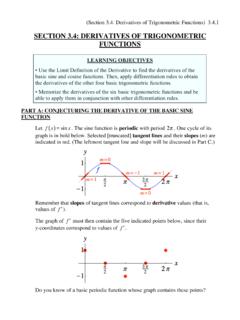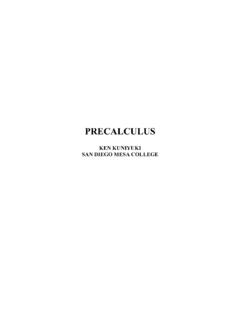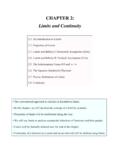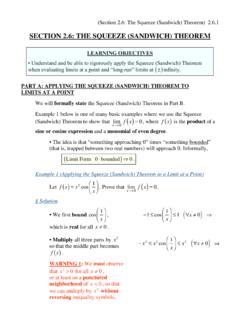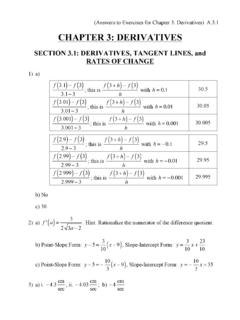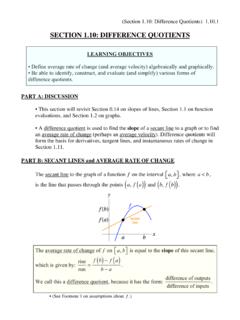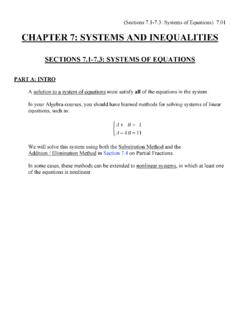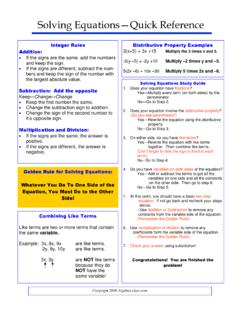Transcription of CHAPTER 1: Functions - kkuniyuk.com
1 CHAPTER 1: Functions : Functions : Graphs of Functions : Basic Graphs and Symmetry : Transformations : Piecewise-Defined Functions ; Limits and Continuity in Calculus : Combining Functions : Symmetry Revisited : x=fy() : Inverses of One-to-One Functions : Difference Quotients : Limits and Derivatives in Calculus Functions are the building blocks of precalculus. In this CHAPTER , we will investigate the general theory of Functions and their graphs. We will study particular categories of Functions in Chapters 2, 3, 4, and even 9. (Section : Functions ) : Functions LEARNING OBJECTIVES Understand what relations and Functions are. Recognize when a relation is also a function. Accurately use function notation and terminology.
2 Know different ways to describe a function. Find the domains and/or ranges of some Functions . Be able to evaluate Functions . PART A: DISCUSSION WARNING 1: The word function has different meanings in mathematics and in common usage. Much of precalculus covers properties, graphs, and categorizations of Functions . A relation relates inputs to outputs. A function is a relation that relates each input in its domain to exactly one output in its range. We will investigate the anatomy of Functions (a name such as f , a function rule, a domain, and a range), look at examples of Functions , find their domains and/or ranges, and evaluate them at an input by determining the resulting output. (Section : Functions ) PART B: RELATIONS A relation is a set of ordered pairs of the form input, output(), where the input is related to ( yields ) the output.
3 WARNING 2: If a is related to b, then b may or may not be related to a. Example 1 (A Relation) Let the relation R=1, 5(), ,5(),5,7(){}. 1, 5() R, so 1 is related to 5 by R. Likewise, is related to 5, and 5 is related to 7. R can be represented by the arrow diagram below. PART C: Functions A relation is a function Each input is related to ( yields ) exactly one output. A function is typically denoted by a letter, most commonly f . Unless otherwise specified, we assume that f represents a function. The domain of a function f is the set of all inputs. It is the set of all first coordinates of the ordered pairs in f . We will denote this by Domf(), although this is not standard. The range of a function f is the set of all resulting outputs.
4 It is the set of all second coordinates of the ordered pairs in f . We will denote this by Rangef(). We assume both sets are nonempty. (See Footnote 1 on terminology.) (Section : Functions ) Example 2 (A Relation that is a Function; Revisiting Example 1) Again, let the relation R=1, 5(), ,5(),5,7(){}. Determine whether or not the relation is also a function. If it is a function, find its domain and its range. Solution Refer to the arrow diagram in Example 1. Each input is related to ( yields ) exactly one output. Therefore, this relation is a function. Its domain is the set of all inputs: 1, ,5{}. Its range is the set of all outputs: 5, 7{}. Do not write 5, 5, 7{}. WARNING 3: Although a function cannot allow one input to yield multiple outputs, a function can allow multiple inputs (such as 1 and in Example 2) to yield the same output (5).
5 However, such a function would not be one-to-one (see Section ). Example 3 (A Relation that is Not a Function) Repeat Example 2 for the relation S, where S=5, 1(),5, (),7,5(){}. Solution S can be represented by the arrow diagram below. An input (5) is related to ( yields ) two different outputs (1 and ). Therefore, this relation is not a function. (Section : Functions ) TIP 1: Think of a function button on a basic calculator such as the x2 or button, which represent squaring and square root Functions , respectively. If a function is applied to the input 5, the calculator can never imply, The outputs are 1 and . Example 4 (Ages of People) For a relation R, The set of inputs is the set of all living people. The outputs are ages in years.
6 A,b() R Person a is b years old. Is this relation a function? Solution Yes, R is a function, because a living person has only one age in years. Example 5 (Colors on Paintings) For a relation S, The set of inputs is the set of all existing paintings. The outputs are colors. a,b() S Painting a has color b. Is this relation a function? Solution No, S is not a function, because there are paintings with more than one color. (Section : Functions ) PART D: EVALUATING Functions (THE BASICS) If an input x Domf(), then its output is a well-defined ( , single) value, denoted by fx(). We refer to x here as the argument of f . We refer to fx() as the function value at x, or the image of x. fx() is read as f of x or f at x.
7 WARNING 4: fx() does not mean f times x. A function can be modeled by an input-output machine such as: x f fx() When we evaluate a function at an input, we determine the resulting output and express it in simplified form. A function is defined (or it exists) only on its domain. If x Domf(), then fx() is undefined (or it does not exist). Example 6 (Evaluating a Function; Revisiting Examples 1 and 2) Let the function f=1, 5(), ,5(),5,7(){}. a) Evaluate f5(). b) Evaluate f6(). Solution a) 5, 7() f, so 5 Domf(), and f5()=7. b) 6 Domf(), so f6() is undefined. (Section : Functions ) Example 7 (Failure to Evaluate a Non-Function; Revisiting Example 3) Let the relation S=5, 1(),5, (),7,5(){}. If we had erroneously identified S as a function and renamed it f , we would see that f5() is not well-defined.
8 It is unclear whether its value should be 1 or . A function rule describes how a function assigns an output to an input. It is typically given by a defining formula such as fx()=x2. Example 8 (Squaring Function: Evaluation) Let fx()=x2 on . This means that we are defining a function f by the rule fx()=x2, with Domf()= . The rule could have been given as, say, fu()=u2. Either way, f squares its input. Evaluate f 3(). Solution We substitute 3() for x, and we square it. fx()=x2 f 3()= 3()2=9 3 f 9 WARNING 5: Be prepared to use grouping symbols whenever you perform a substitution; only omit them if you are sure you do not need them. Note that f 3() is not equal to 32, which equals 9. (Section : Functions ) WARNING 6: As a matter of convenience, some sources refer to fx() as a function, but this convention is often rejected as non-rigorous.
9 One advantage to the fx() notation is that it indicates that f is a function of one variable. The notation fx,y() indicates that f is a function of two variables. A function can be determined by a domain and a function rule. Together, the domain and the function rule determine the range of the function. (See Footnote 1.) Two Functions with the same rule but different domains are considered to be different. Piecewise-defined Functions will be discussed in Section Such a function applies different rules to disjoint (non-overlapping) subsets of its domain (subdomains). For example, consider the function f , where: fx()=x2, 2 x<1x+1,1 x 2 PART E: POLYNOMIAL, RATIONAL, AND ALGEBRAIC Functions Review Section on polynomial, rational, and algebraic expressions.
10 F is a polynomial function on f can be defined by: fx()= (a polynomial in x), which implies that Domf()= . See Footnote 2 on whether polynomial Functions can be defined on another domain. x could be replaced by another variable. f is a rational function f can be defined by: fx()= (a rational expression in x). f is an algebraic function f can be defined by: fx()= (an algebraic expression in x). Example 9 (Polynomial, Rational, and Algebraic Functions ) a) Let fx()=x3+7x5/7x x+53+ . Then, f is an algebraic function. b) Let gt()=5t3 1t2+7t 2. Then, g is both rational and algebraic. c) Let hx()=x7+ x2 3. Then, h is polynomial, rational, and algebraic. (Section : Functions ) PART F: REPRESENTATIONS OF Functions Ways to Represent a Function Rule The domain of the function could be the implied domain (see Part G).
